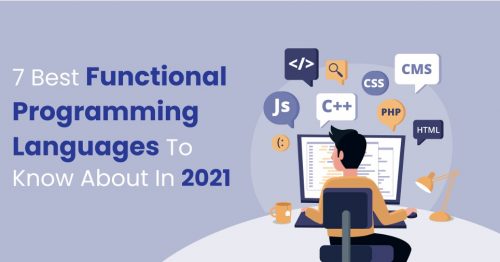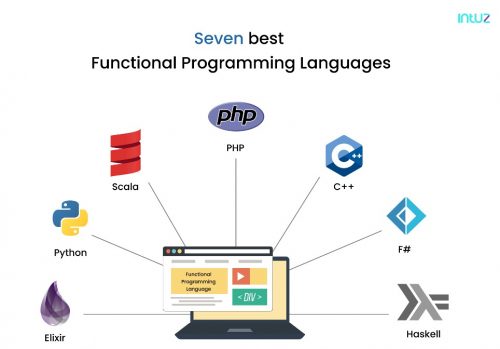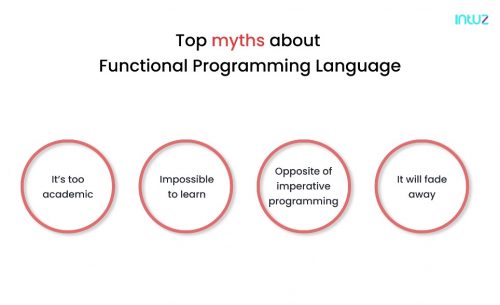Unless you have been living under a rock, you will agree that functional programming is a rage among developers. From traditional programming languages such as Javascript development, C#, and programming languages used for artificial intelligence, to more modern ones like Scala and Swift development, there is a lot to learn about the appropriateness of functional programming for everyday app development.

If you are interested in functional programming, you have already made a fine choice. Not only do you have a few great sets of options to choose from for your iPhone app development, but also you can benefit much from them.
Functional programming paradigm – An overview
Programming paradigms are mainly of 3 kinds — procedural, object-oriented, and those following the functional programming paradigm. We come across these terms now and then but rarely find anyone talking about them in the broad sense.
Procedural programming [a typical example would be PHP] is low-level and quite fundamental. You state what you are doing step by step, explicitly, to the system.
Object-oriented programming [OOP] takes the lion’s share of modern development today. Almost every language that you can think of is probably object-oriented in some way. The definitions are easy too. It is the language that can manipulate objects (read: data) by programmed methods.
When it comes to Functional Programming, though, you will find that the new languages out there, such as Haskell, F#, and Elixir, create all the noise, and for a good reason. We put functional programming to use when our goal is the result, not particularly how we got there.
For all practical purposes, a functional programming language deals with “pure functions,” which always return the same output for the same input. However, there are other valid definitions for it.
In computer science, however, the functional programming paradigm is where programs are constructed by applying and composing functions.
What is trending in functional programming?
Until a few years ago, functional programming was barely anything more than a buzzword. Everyone talked about it, but nobody seemed to use it. But now, the tide is rising. Developers and enterprises cannot do without it anymore.
Functional programming languages have started to become popular in the software industry. Haskell, say, is used by Facebook to tackle spam abuse at scale. On the other hand, Whatsapp uses Erlang to achieve concurrency for billions of users on the planet every day.
But then again, other companies still struggle to implement functional concepts on their software products. If they succeed, it will give them an edge over their competitors.
On another note, while Swift development is taking off, it is strange that other new languages are gaining little recognition, and then, of course, adoption. To gain recognition and get adopted at scale, the most obvious method for a functional programming language would be to develop an app that makes some noise.
This is a niche sector, and those who know these languages inside out will be in high demand as we see some emerging trends in iOS development services and cloud computing. All developers need is a paradigm-shifting application of the best functional programming languages of the future to kickstart a programming revolution.
Examples of functional programming languages
While most of the languages that we know of are object-oriented, a few of them try to bind every piece of information or instruction in strictly mathematical terms. These languages are called functional programming languages.
Common examples include:
- Lisp (the first FP language)
- Haskell
- Scala
- Erlang
- Elixir, among others
Those who are into JavaScript development think the programming language is functional, but it is object-oriented in reality. Nonetheless, you can write Javascript programs in a functional style in iPhone app creation.
Seven best functional programming languages
Now that you have a broad understanding of the concept and its market trends, let us now take a look at the seven best functional programming languages you should know about in 2021:

-
Elixir
Elixir is a compelling functional language built on the strong points of its predecessor Ruby and Erlang, keeping scalability in mind. It was created by Jose Valim in 2011, who leveraged the Erlang VM platform for its extremely low latency and fault-tolerant systems.
The Elixir framework finds its use in the embedded software arena, web development, and any other application or micro-service that heavily relies on performance and speed (IoT and cloud computing, for instance).
Features:
- Language is functional, and data is immutable, which makes it easy to hunt down bugs.
- It emphasizes small, concise functions with a clear purpose, thus making fundamental changes more quickly.
- It uses the Phoenix framework to create thousands of processes rapidly without worrying about their impact on performance.
-
Python
Python is a high-level language that incorporates the concepts of all three programming paradigms, yet its functional component is something that most Python developers are unaware of. But that might be because it is mostly advertised as being object-oriented.
As for functional programming, Python allows you to code in a declarative fashion and supports a large set of built-in functions like the map(), filter(), sorted(), enumerate(), among others, and even Lambda Expressions. In most cases, functional programming allows you to write a relatively efficient and concise Python code with no side-effects.
Features:
- Used to develop 2D imaging and 3D animation packages such as Autodesk, Blender, and Inkscape
- Comes with highly regarded official tutorials and documentation
- Mature and stable enough to be compatible with high-performance algorithms and advanced technologies such as AI, ML, and predictive analysis
-
Scala
Scala is a functional programming language that most developers today are trying to learn as an alternative to Java for iOS app. It has left both Kotlin and Groovy far behind as the best functional programming language.
Like Python, it is multi-paradigm and uses the best portions of OOP and functional programming to leverage multi-core CPU architectures. Various major companies across the globe, including Netflix, Twitter, Airbnb, LinkedIn, and so on, use Scala for many purposes ranging from Android and iPhone app building to machine learning.
Features:
- It is more concise as compared to Java.
- It is a flexible, scalable, open-source clustered computing framework when paired with Apache Spark and can make use of large hardware resource pools efficiently.
- It is potentially more marketable, thanks to the various books and guides that keep getting published.
- It boasts of a community that keeps growing.
-
PHP
Danish-Canadian programmer Rasmus Lerdorf developed this open-source programming language in 1990. Today, more than 80% of websites, including Yahoo! and Facebook, are built using PHP.
Most developers working on programming languages such as Scala and Haskell are not aware that PHP has a lot to offer regarding the functional programming paradigm. Almost all its concepts can be expressed in PHP.
But again, while it can be fun, it is recommended that entire PHP applications be developed using functional programming and only parts of the operating concept be used in everyday programming.
That is why developers mainly use PHP to write server-side scripts and command-line scripts. Since it is a relatively easy language, PHP has many dedicated online communities, making it easy for developers to exchange knowledge.
Features:
- Perfect for cross-platform use—mobile, desktop, and web
- Easy to develop and can be integrated with many third-party applications
- Flexible with superior database connectivity
-
C++
Just like Python, it might come as a surprise that C++ has functional components as well. While OOP was the original intention behind its development, the language has grown to become more concise, safer, and more readable in the past few years—a perfect choice for iOS development services.
In terms of functional programming, it did so by minimizing the moving parts in its system instead of encapsulating them as it happens in OOP.
In C++, you also have lambda functions, polymorphic functions, and forward class wrapper functions. It also made the language immutable and recursion-friendly, but it shows its true potential for parallel processing.
Features:
- C++ code is portable, meaning you can use the same piece of code in different environments.
- It is a compiler-based language and hence, much faster than Python and Java.
- Since it supports the use of pointers, you can allocate memory dynamically.
-
F#
F# is a functional-first language primarily developed by Microsoft to move toward interoperability before it encouraged the open-source community to contribute to their project.
It has an engaging console where you can implement REPL effortlessly and use both programming and scripting language.
It treats functions as values and uses them in expressions without naming them. Overall, its primary purpose is to write and manipulate maintainable code in iPhone app development quickly.
Features:
- It has been designed specifically for functional programming on .NET.
- High-quality editors for macOS, Windows, and Linux run on a single F# compiler.
- It is an open-source language by Microsoft, which means it has a thriving community.
-
Haskell
Haskell is one of the few purely functional programming languages published as early as 1990. The functions written are entirely mathematical and have never shown any side effects. It is so good that not only did it become a standard functional programming language after its release, but it also led to the creation of various other derived languages such as Swift development.
Features:
- Every expression in Haskell has a type that determines at compile time.
- It is centered around immutable data and pure functions.
- You do not need to write every type in a Haskell program explicitly.
- Since it is open-source, Haskell contributors are very active.
Top myths about functional programming language
Anything worth bringing a revolution comes with its fair share of myths. Adding to that thought, let us take a look at common myths associated with any functional programming language:

-
“It’s too academic.”
That is not true. As mentioned above, each language is getting implemented in a real-world application. While the entire concept inclusively solves the purpose of reducing side effects in the final software, each language is used in a particular industry.
For instance, Facebook uses Haskell to manage spam abuse at scale; WhatsApp uses Erlang to serve data to all the users concurrently. Even Swift is used by scores of famous companies such as Slack, Airbnb, Twitter, Lyft, Uber etc.
-
“It is impossible to learn.”
For those new at it, yes, you might have to put in a little extra effort if you are learning any functional programming language by yourself. However, that notion is true for almost anything you will ever try to learn for the first time.
-
“It is the polar opposite of imperative programming.”
Functional programming and object-oriented programming do not stand in stark contrast. Remember how Python is a high-level language incorporating the concepts of all three programming paradigms? There are no purely functional concurrent collections.
-
“It is just a fad. It will fade away.”
No, and no—none of it is true. Lisp, the first functional programming language, was developed in 1958. People are interested in learning it now because today, the applications are tangible, and the future, more predictable.
-
“There is only one definition.”
As you might have realized, there are many components to functional programming, and hence, there is no single definition of this paradigm. So, the fact that there is only one definition of available programming is not valid.
Wrapping up
Functional programming is the stepping stone of today’s development panorama. Yet, while a few instances of its successful application, the functional programming paradigm is a part of the mainstream iOS solutions.
Interesting Related Article: “5 Tips to Beginning with Software Development“

